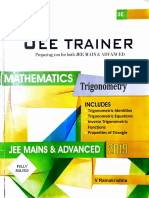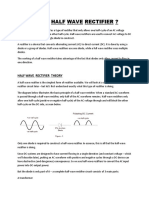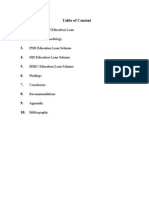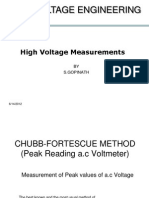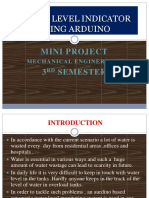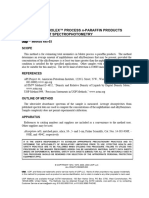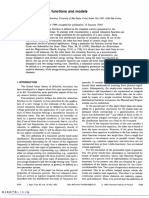0 ratings0% found this document useful (0 votes)
79 viewsFULL Wave
FULL Wave
Uploaded by
Manish BhardwajThis document describes constructing a full wave rectifier circuit to convert alternating current to direct current. It explains that a full wave rectifier uses two diodes to rectify both halves of the AC wave, improving on a half wave rectifier. The circuit uses a transformer to step down household AC voltage to 6V, which is then rectified by the diodes and filtered by a capacitor to produce DC voltage that lights an LED. The document provides details on connecting the components and how the circuit works during each half cycle to allow current flow in only one direction, producing rectified DC output.
Copyright:
© All Rights Reserved
Available Formats
Download as PDF, TXT or read online from Scribd
FULL Wave
FULL Wave
Uploaded by
Manish Bhardwaj0 ratings0% found this document useful (0 votes)
79 views7 pagesThis document describes constructing a full wave rectifier circuit to convert alternating current to direct current. It explains that a full wave rectifier uses two diodes to rectify both halves of the AC wave, improving on a half wave rectifier. The circuit uses a transformer to step down household AC voltage to 6V, which is then rectified by the diodes and filtered by a capacitor to produce DC voltage that lights an LED. The document provides details on connecting the components and how the circuit works during each half cycle to allow current flow in only one direction, producing rectified DC output.
Original Description:
Full wave
Original Title
FULL wave
Copyright
© © All Rights Reserved
Available Formats
PDF, TXT or read online from Scribd
Share this document
Did you find this document useful?
Is this content inappropriate?
This document describes constructing a full wave rectifier circuit to convert alternating current to direct current. It explains that a full wave rectifier uses two diodes to rectify both halves of the AC wave, improving on a half wave rectifier. The circuit uses a transformer to step down household AC voltage to 6V, which is then rectified by the diodes and filtered by a capacitor to produce DC voltage that lights an LED. The document provides details on connecting the components and how the circuit works during each half cycle to allow current flow in only one direction, producing rectified DC output.
Copyright:
© All Rights Reserved
Available Formats
Download as PDF, TXT or read online from Scribd
Download as pdf or txt
0 ratings0% found this document useful (0 votes)
79 views7 pagesFULL Wave
FULL Wave
Uploaded by
Manish BhardwajThis document describes constructing a full wave rectifier circuit to convert alternating current to direct current. It explains that a full wave rectifier uses two diodes to rectify both halves of the AC wave, improving on a half wave rectifier. The circuit uses a transformer to step down household AC voltage to 6V, which is then rectified by the diodes and filtered by a capacitor to produce DC voltage that lights an LED. The document provides details on connecting the components and how the circuit works during each half cycle to allow current flow in only one direction, producing rectified DC output.
Copyright:
© All Rights Reserved
Available Formats
Download as PDF, TXT or read online from Scribd
Download as pdf or txt
You are on page 1of 7
INDEX
AIM
“To construct a full wave rectifier
and show that Alternating Current
is rectified into a Direct Current”
INTRODUCTION
A full wave rectifier is a device which is used
to rectify all the alternating current
components in an alternating supply and
make it purely a direct current. The two
alternating halves of an alternation current
are rectified in a full wave rectifier which is
an advantage over a half wave rectifier. Most
electronic devices cannot withstand very high
voltage or alternating current due to its
intense high power. The use of batteries in
all devices is not practical as their
replacement and durability is a huge problem
as the device has to be dismantled each
time for such a replacement. So these
rectifiers are used in most of the electronic
devices like TV’s, Radios, Chargers,and
Lightings etc.
MATERIALS
REQUIRED
Connection details:
Connections are done as in the circuit. The
A.C. supply is given to both the input wires
of the transformer and the two ends of the
secondary coil is given to the P side of the
two diodes and the N side of the diodes are
twined and then connected to one end of the
capacitor and the other end to the center tap
lead and to the resistor. Further, the other
end of capacitor with the diode connect ion
is connected to the other end of the resistor.
Connect 2 leads on both the ends of the
resistor to measure the output and this is
connected to the +ve & -ve terminals of the
bulb.
1st when the A.C. is supplied to the
transformer, it steps down the 230V
main supply to 6 volts. It has a capability
of delivering a current of 500mA. The 6
volts A.C. appearing across the
secondary is the RMS value and the peak
value is 8.4 volts. During the 1st half
cycle of the A.C. input Diode D1 is
forward biased and a current ‘I’ flows in
the circuit in the direction S1 D1 ABEO
S1. During this time diode D2 is reverse
biased. So it does not conduct any
electric current. During the next half
cycle, the diode D2 is forward and D1 is
reversed. Hence D2 conducts current in
the direction S2D2 ABEO S2and D1 does
not conduct any current. In subsequent
half cycles of the A.C current the above
processes are repeated.
In both the half cycles it is clear that current
flows through the resistor in only one
direction ABE. Even though the voltage
across RL is unidirectional it will still contain
a few A.C components. This is filtered and
made smooth using a capacitor, which filters
99% of the A.C current. A resistor is then
used to adjust the output voltage. Capacitor
also nearly filters all A.C components from
the supply and resistance is adjusted for the
required output. As this is a simple circuit,
only one capacitor and a resistance are being
used. But there will be slight factor of A.C.
current still left in the output but it is
negligible. The output Direct Current and
voltage Light up the LED.
You might also like
- Ativeer Jee TrigonometryDocument22 pagesAtiveer Jee Trigonometrymohan sai praneeth100% (2)
- Grade 8 Module 1 - Newtons Law of MotionDocument24 pagesGrade 8 Module 1 - Newtons Law of Motionjohn charles garaldeNo ratings yet
- Full Wave RectifierDocument6 pagesFull Wave RectifierAtul Namdeo0% (1)
- Full Wave RectifierDocument10 pagesFull Wave Rectifierdheerajguptaandro20% (5)
- Full Wave Bridge RectifierDocument4 pagesFull Wave Bridge RectifierSachit KumarNo ratings yet
- Physics ProjectDocument11 pagesPhysics ProjectBoves AlexNo ratings yet
- BE8261 - BEEIE Lab Manual For II Sem Mech/ AeroDocument123 pagesBE8261 - BEEIE Lab Manual For II Sem Mech/ AeroRAJARAJAN RNo ratings yet
- PhysicsDocument13 pagesPhysics42,Vansh 8th DNo ratings yet
- Half Wave RectifierDocument17 pagesHalf Wave RectifierNishanthi BheemanNo ratings yet
- EMMI Important Question Bank With AnsDocument17 pagesEMMI Important Question Bank With AnsrsriyarNo ratings yet
- Physics Project Sample Copy Std. 12Document21 pagesPhysics Project Sample Copy Std. 12cytrfNo ratings yet
- 132 KV Gss Chambal Powerhouse Sodala, JaipurDocument37 pages132 KV Gss Chambal Powerhouse Sodala, Jaipurshambu meenaNo ratings yet
- Physics Project ON: Full Wave RectifierDocument11 pagesPhysics Project ON: Full Wave RectifierkartikNo ratings yet
- Project Report (DC Fan Regulator)Document19 pagesProject Report (DC Fan Regulator)tsuu0213No ratings yet
- Physics Project FinalDocument13 pagesPhysics Project Finalveenu68No ratings yet
- Introduction of RectifierDocument4 pagesIntroduction of RectifierSuraj100% (1)
- Class 12 Physics ProjectDocument14 pagesClass 12 Physics ProjectSRIJAN MANI TRIPATHINo ratings yet
- Major Project Report: "Emergency Light Using SCR"Document5 pagesMajor Project Report: "Emergency Light Using SCR"Vasu ThakurNo ratings yet
- Power Electronics Lesson PlanDocument5 pagesPower Electronics Lesson PlanViswa NathanNo ratings yet
- Half Wave and Full Wave RectifierDocument8 pagesHalf Wave and Full Wave Rectifierbolbo naNo ratings yet
- Rain AlarmDocument25 pagesRain AlarmEkta Jolly100% (4)
- Transformer On Auto Load Shifting With CuttoffDocument20 pagesTransformer On Auto Load Shifting With Cuttoffbhaumikjoshi joshiNo ratings yet
- Half Wave RectifierDocument6 pagesHalf Wave RectifierAnmol Dubey33% (3)
- Full Wave RectifierDocument5 pagesFull Wave Rectifierसूरज कुमार0% (1)
- How To Make A DC Mobile ChargerDocument12 pagesHow To Make A DC Mobile ChargerZeeShanShahNo ratings yet
- Physics Project (2019-20)Document10 pagesPhysics Project (2019-20)Aryan MedakNo ratings yet
- Faculty Lecture Notes On (Wheatstone Bridge)Document8 pagesFaculty Lecture Notes On (Wheatstone Bridge)rajeevNo ratings yet
- Time Constant of RC CircuitDocument13 pagesTime Constant of RC CircuitADRMNo ratings yet
- Group 7 Final Project Report - Automatic Night LightDocument15 pagesGroup 7 Final Project Report - Automatic Night LightBen RileyNo ratings yet
- Automatic Street Light Controller Using LDRDocument43 pagesAutomatic Street Light Controller Using LDRDarshanRupaniNo ratings yet
- School 123Document15 pagesSchool 123piyushchaudhary976No ratings yet
- Ultra Fast Acting Electronic Circuit BreakerDocument6 pagesUltra Fast Acting Electronic Circuit BreakerHarish Kumar100% (1)
- Final PPT Automatic Water HeaterDocument13 pagesFinal PPT Automatic Water HeaterYogita Ghumare100% (1)
- 17ee82 - Ida - Mod 3 NotesDocument38 pages17ee82 - Ida - Mod 3 NotesManish Kumar SahaniNo ratings yet
- Electronic EyeDocument14 pagesElectronic EyeHajarath Prasad Abburu100% (1)
- Education Loan With Reference To Sbi PNB and HSBC"Document63 pagesEducation Loan With Reference To Sbi PNB and HSBC"jfdj_898jgkgfNo ratings yet
- Half Wave and Full Wave RectificationDocument3 pagesHalf Wave and Full Wave RectificationBruh HDHDNo ratings yet
- Cutm Examination HandbookDocument73 pagesCutm Examination HandbookTarun Kumar PradhanNo ratings yet
- CEP - Measurement and Instrumentation - Spring 2020Document3 pagesCEP - Measurement and Instrumentation - Spring 2020Saad AliKhanNo ratings yet
- EE8261-Electric Circuits Lab Manual PDFDocument91 pagesEE8261-Electric Circuits Lab Manual PDFPraveen Kumar50% (2)
- Report On HVDCDocument18 pagesReport On HVDCBARUN SINGHNo ratings yet
- Emergency Light FinalDocument35 pagesEmergency Light Finalritesh chauhanNo ratings yet
- EXP2 Half Wave RectifierDocument3 pagesEXP2 Half Wave RectifierMohammed Dyhia Ali50% (2)
- PotentiometerDocument5 pagesPotentiometernaiyemchowdhuryrony100% (1)
- Automatic Street Light ControllerDocument16 pagesAutomatic Street Light ControllerAsif Newaz Khan100% (2)
- Expt 5 - Wein Bridge Oscillator (2020)Document3 pagesExpt 5 - Wein Bridge Oscillator (2020)samarthNo ratings yet
- Full Wave RectifierDocument9 pagesFull Wave RectifierPUNEET BATRA0% (1)
- PROJECT - PhysicsDocument8 pagesPROJECT - PhysicsAtul TiwariNo ratings yet
- Chubb Fortescue MethodDocument10 pagesChubb Fortescue MethodGopinath Singaram100% (2)
- Sanay ProjectDocument12 pagesSanay ProjectToxicNo ratings yet
- Phy PotentiometerDocument20 pagesPhy PotentiometerDanyRaj100% (3)
- Full Wave RectifierDocument11 pagesFull Wave Rectifierhimanshu.002tNo ratings yet
- Experiment No. 7: Numerical Aperture of The Optical FiberDocument4 pagesExperiment No. 7: Numerical Aperture of The Optical FiberDhiraj DhaneshNo ratings yet
- Physics Project Report 2Document15 pagesPhysics Project Report 2Ark Dutta0% (2)
- Lab 3 Clipping and Clamping Circuits 2 1112Document10 pagesLab 3 Clipping and Clamping Circuits 2 1112Mei GuanNo ratings yet
- Physics Project ON Full Wave Rectifier: By: Daksh Patel STD: Xii - B Roll No: 12Document11 pagesPhysics Project ON Full Wave Rectifier: By: Daksh Patel STD: Xii - B Roll No: 12Dipesh PundirNo ratings yet
- Ac GeneratorDocument16 pagesAc Generatorsunil kumar guptaNo ratings yet
- Miniproject Water Level IndicatorDocument19 pagesMiniproject Water Level IndicatorTathagat TripathyNo ratings yet
- Full Wave Rectifier Class 12 Project ReportDocument5 pagesFull Wave Rectifier Class 12 Project ReportSaurav Kar75% (4)
- final phyDocument10 pagesfinal physurajvermaa0904No ratings yet
- PhysicsDocument11 pagesPhysicspraveensivan22No ratings yet
- University Institute of Engineering22Document4 pagesUniversity Institute of Engineering22harshit dheerNo ratings yet
- Objective Questions Unit - 1 Class 12Document20 pagesObjective Questions Unit - 1 Class 12AdityaNo ratings yet
- Pre-Laboratory#5 - CHEM1103 - DETERMINATION OF HEAT OF COMBUSTION USING A BOMB CALORIMETERDocument3 pagesPre-Laboratory#5 - CHEM1103 - DETERMINATION OF HEAT OF COMBUSTION USING A BOMB CALORIMETERMarielleCaindecNo ratings yet
- Work, Energy, and PowerDocument22 pagesWork, Energy, and PowerSaint Lalibela TubeNo ratings yet
- Servicemanual: Sony@Document57 pagesServicemanual: Sony@Вячеслав ГлушакNo ratings yet
- Lecture 2-3 - Introduction To Aerodynamics & FundamentalsDocument15 pagesLecture 2-3 - Introduction To Aerodynamics & FundamentalsAli RazaNo ratings yet
- CET203 FLUID MECHANICS AND HYDRAULICS, December 2020Document3 pagesCET203 FLUID MECHANICS AND HYDRAULICS, December 2020cedayan418No ratings yet
- Performance Testing of Different Grounding SystemsDocument8 pagesPerformance Testing of Different Grounding SystemsFernandoCrespoMonNo ratings yet
- Uop495 03Document8 pagesUop495 03wilfred gomezNo ratings yet
- Tense DT-96EM DT-72EM DT-48EM enDocument4 pagesTense DT-96EM DT-72EM DT-48EM enavocelNo ratings yet
- TheodoliteDocument10 pagesTheodoliteNikita SharmaNo ratings yet
- TNPSC Group 2 Complete Syllabus: TNPSC Group 2 Previous Questions: TNPSC Group 2 Model QuestionsDocument7 pagesTNPSC Group 2 Complete Syllabus: TNPSC Group 2 Previous Questions: TNPSC Group 2 Model QuestionsanbuNo ratings yet
- Unit 4 Torsion ProblemsDocument19 pagesUnit 4 Torsion ProblemsAnonymous mRBbdopMKfNo ratings yet
- Dielectric Relaxation Functions and Models - Gross - 1990Document6 pagesDielectric Relaxation Functions and Models - Gross - 1990AP SinghNo ratings yet
- An Engineering Approach in Modeling Overvoltage Effects On Wind Parks Caused by Travelling WavesDocument5 pagesAn Engineering Approach in Modeling Overvoltage Effects On Wind Parks Caused by Travelling WavesLuis José RodríguezNo ratings yet
- To Study The Variations of Current Flowing in A Circuit Contaiang LDRDocument12 pagesTo Study The Variations of Current Flowing in A Circuit Contaiang LDRTANISHK YADAVNo ratings yet
- CC 220 Charging ScaleDocument2 pagesCC 220 Charging ScaleNay Htoo ZawNo ratings yet
- Hydrostatic ProblemsDocument5 pagesHydrostatic ProblemsouanNo ratings yet
- DHM 6 Set: Mini Instantaneous Water Heater PRODUCT-NO.: 236452Document4 pagesDHM 6 Set: Mini Instantaneous Water Heater PRODUCT-NO.: 236452Cire Lop CastroNo ratings yet
- Mbrb2035Ct Thru Mbrb2060Ct: Schottky RectifierDocument2 pagesMbrb2035Ct Thru Mbrb2060Ct: Schottky RectifierJOHN BRICCO A. MATACSILNo ratings yet
- Piezo-Electric EI EX 604Document13 pagesPiezo-Electric EI EX 604neha_542407919No ratings yet
- Spectrometer I I Curve XXDocument5 pagesSpectrometer I I Curve XXArunnarenNo ratings yet
- Weights, Mesurements, and SubstitutionsDocument22 pagesWeights, Mesurements, and SubstitutionsSarah Jean MaturanNo ratings yet
- RESEARCH PLAN. Energy Harvesting Through Piezoelectric Generator Installed To Footwear.Document10 pagesRESEARCH PLAN. Energy Harvesting Through Piezoelectric Generator Installed To Footwear.EllieNo ratings yet
- Proficiency Testing Determines The Performance of Individual Laboratories For Specific Tests or Measurements and Is Used To Monitor LaboratoriesDocument2 pagesProficiency Testing Determines The Performance of Individual Laboratories For Specific Tests or Measurements and Is Used To Monitor LaboratoriesAli RazaNo ratings yet
- Lecture11-Earthquake MagnitudeDocument41 pagesLecture11-Earthquake MagnitudePoojaNo ratings yet
- SLM CSS M8Document23 pagesSLM CSS M8Renato Lim Baylas Jr.No ratings yet
- Week-4 Lecture-4 Analog Indicating Instruments: Chapter 2: BakshiDocument33 pagesWeek-4 Lecture-4 Analog Indicating Instruments: Chapter 2: Bakshiahmad khanNo ratings yet
- Comparative Analysis of Manual Strapping Method (MSM) and Electro-Optical Distance Ranging (EODR) Method of Tank CalibrationDocument11 pagesComparative Analysis of Manual Strapping Method (MSM) and Electro-Optical Distance Ranging (EODR) Method of Tank CalibrationMahmoud GaberNo ratings yet
